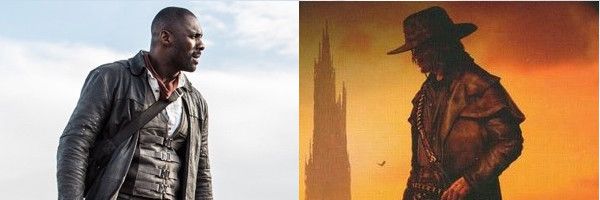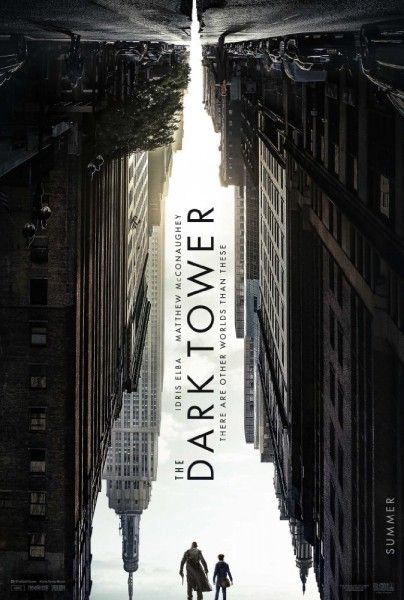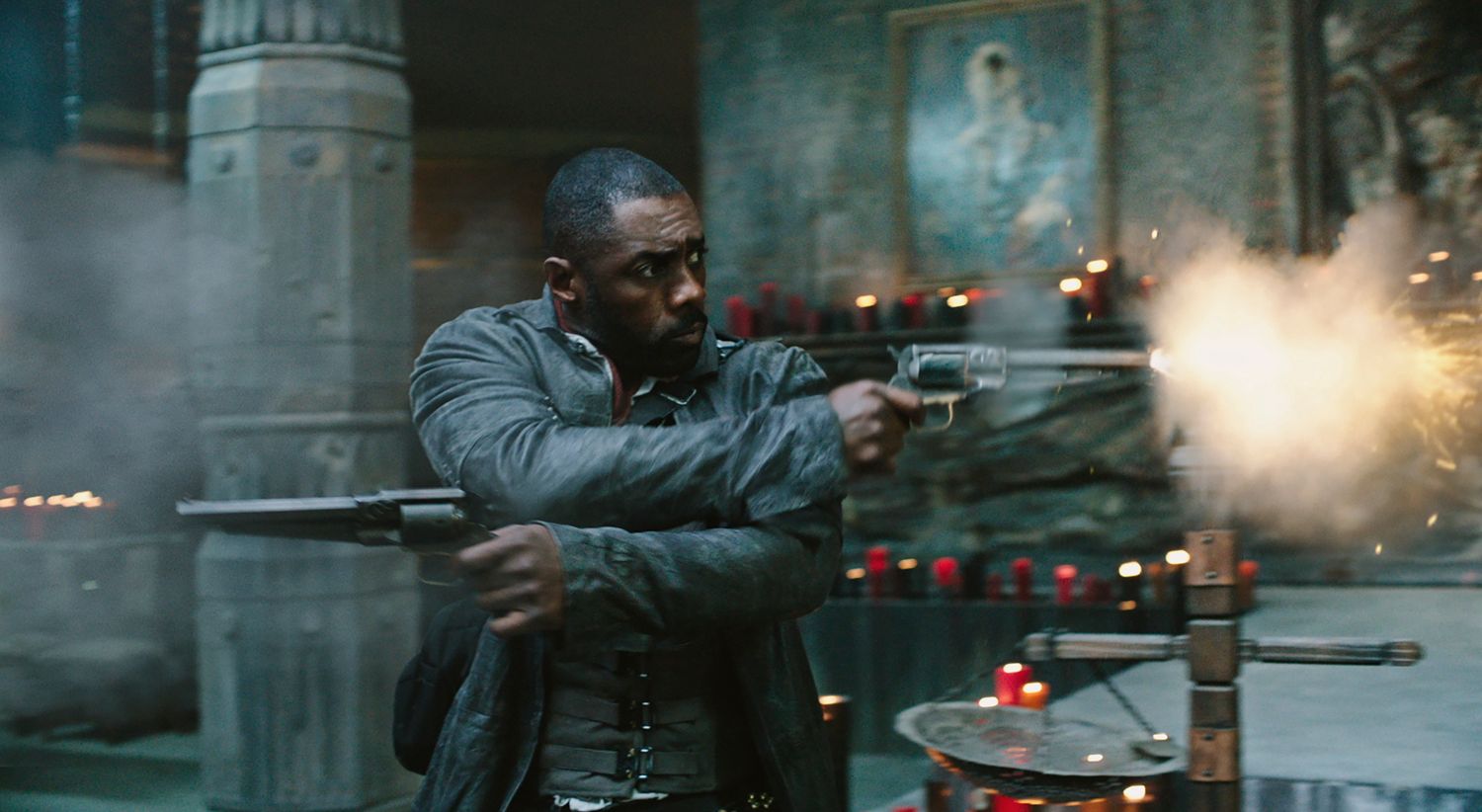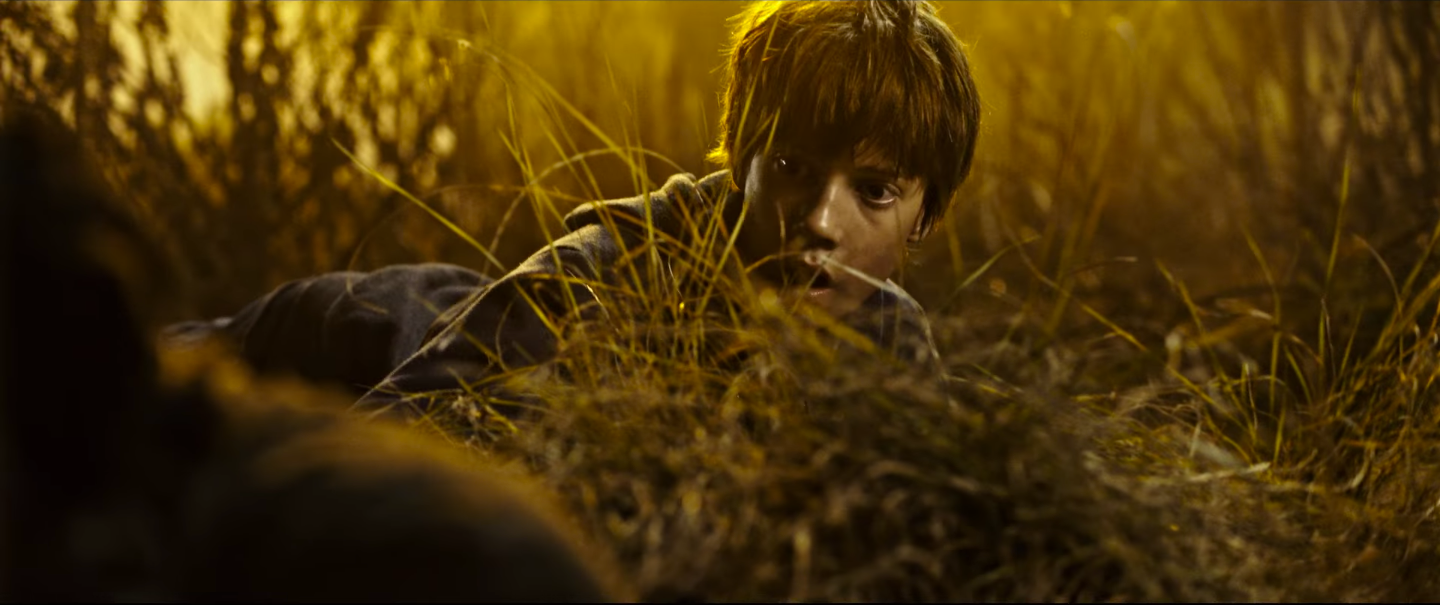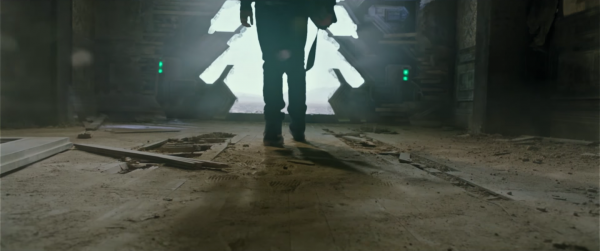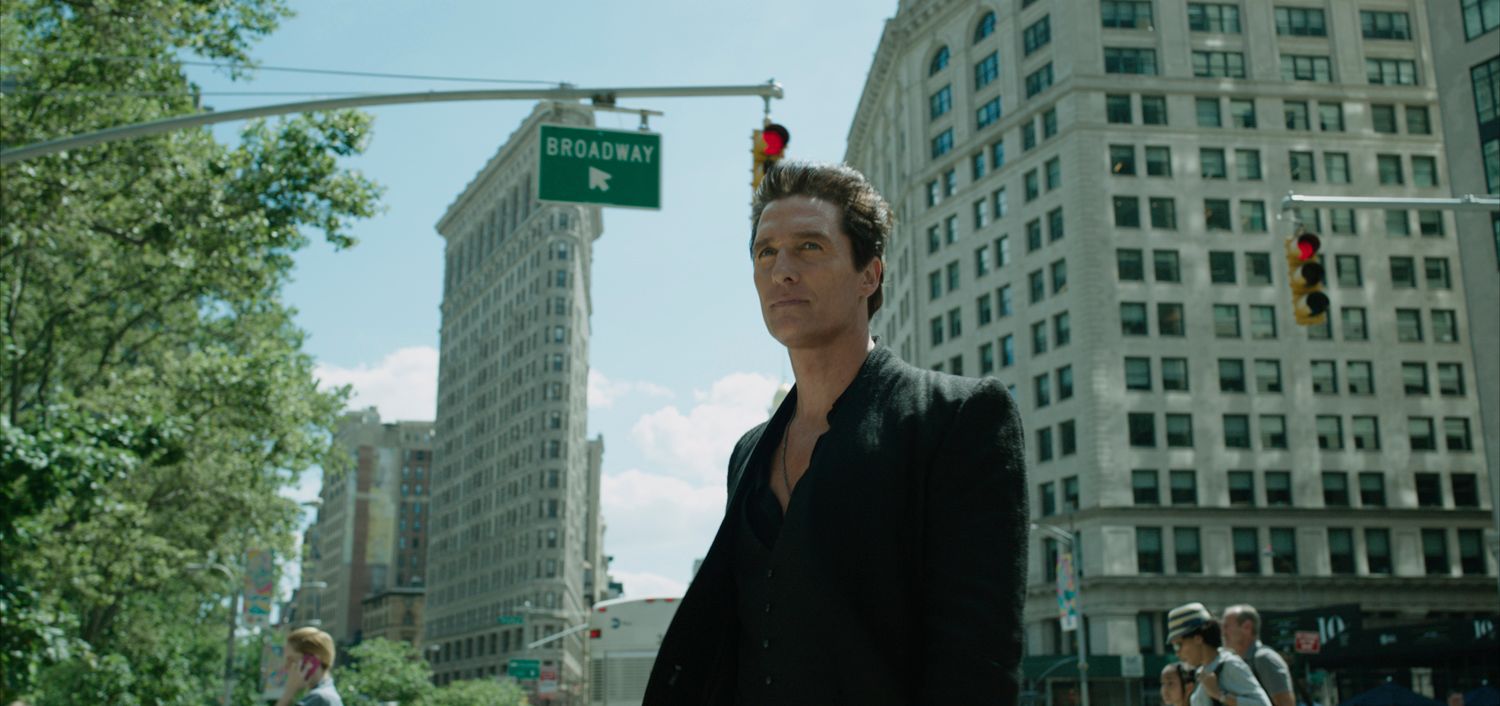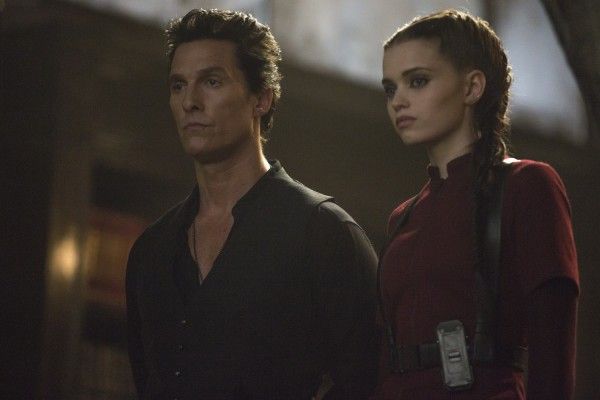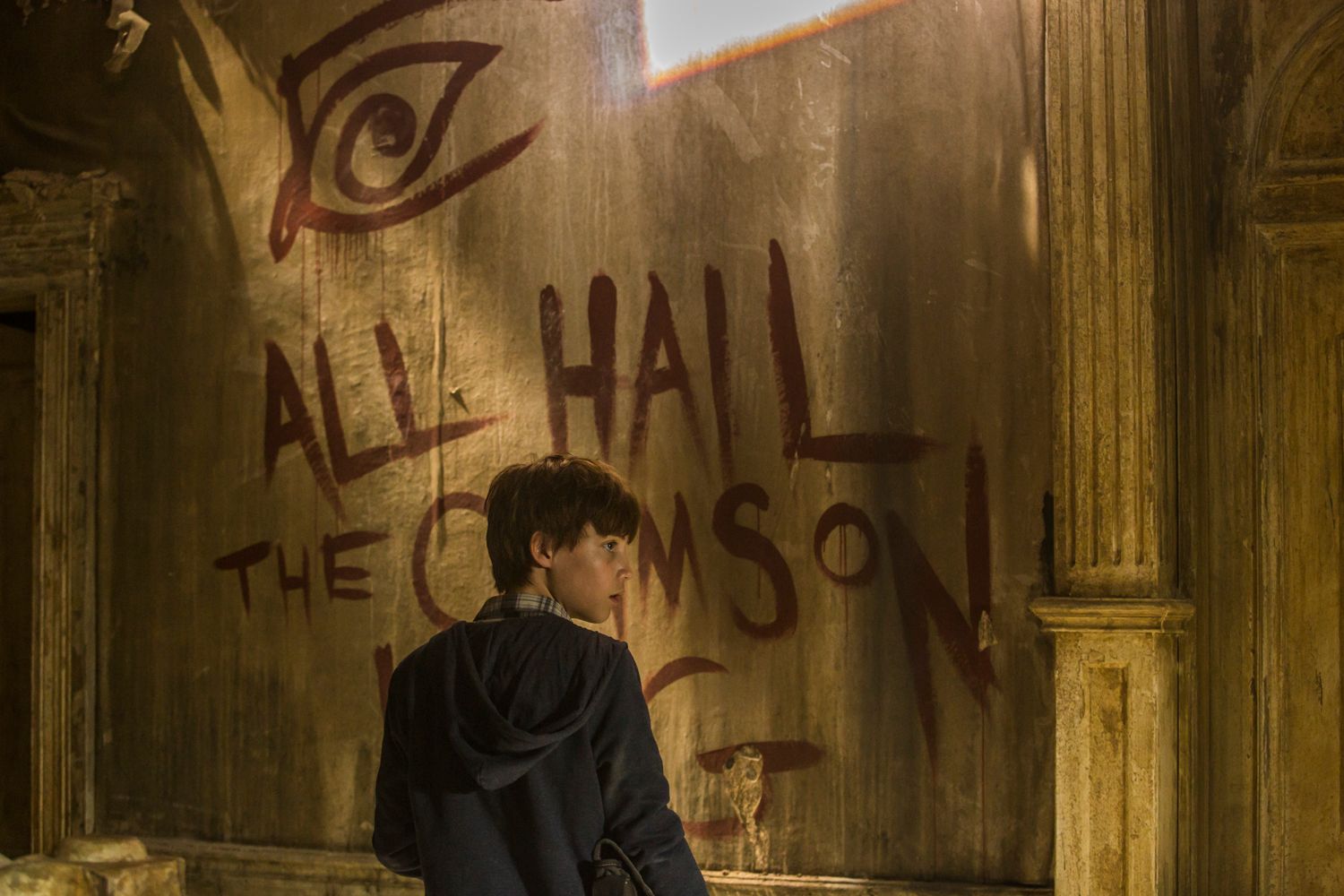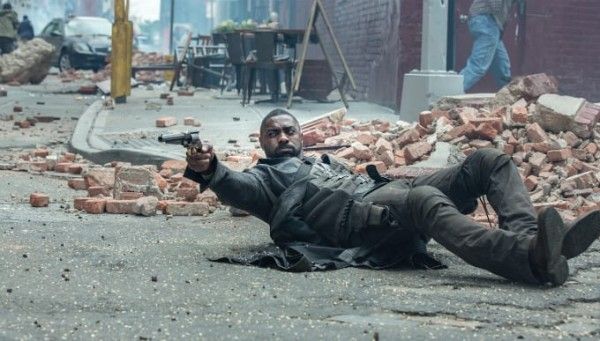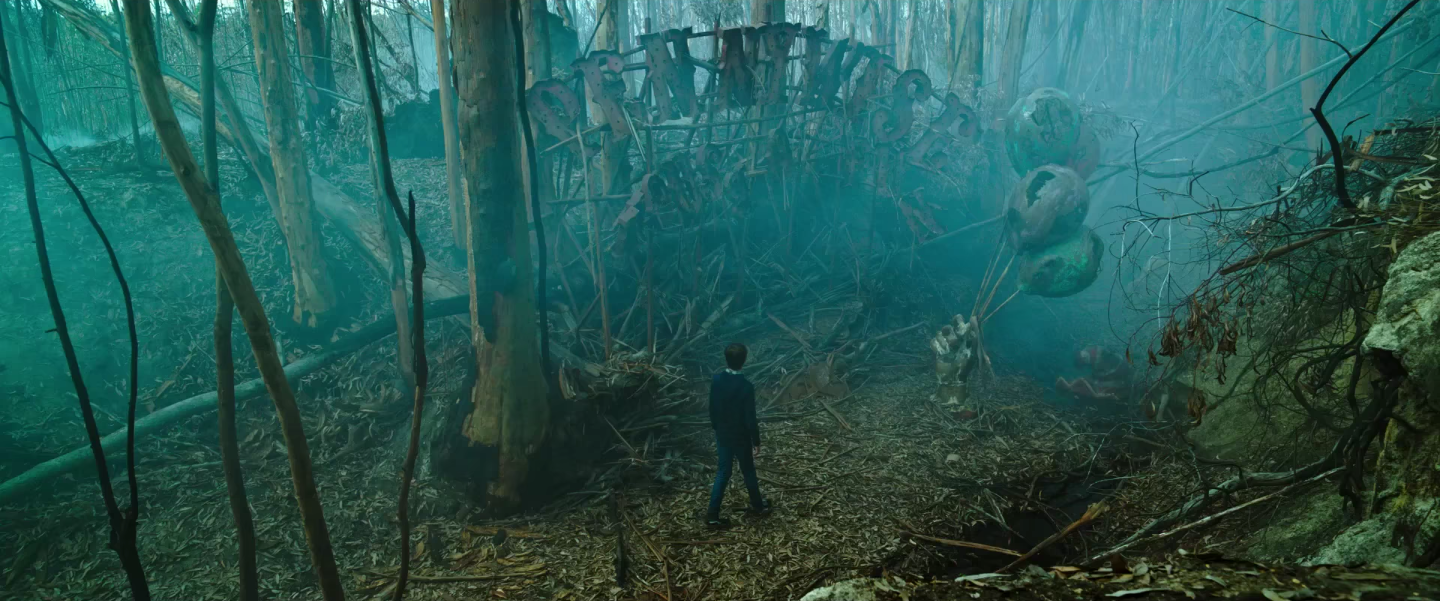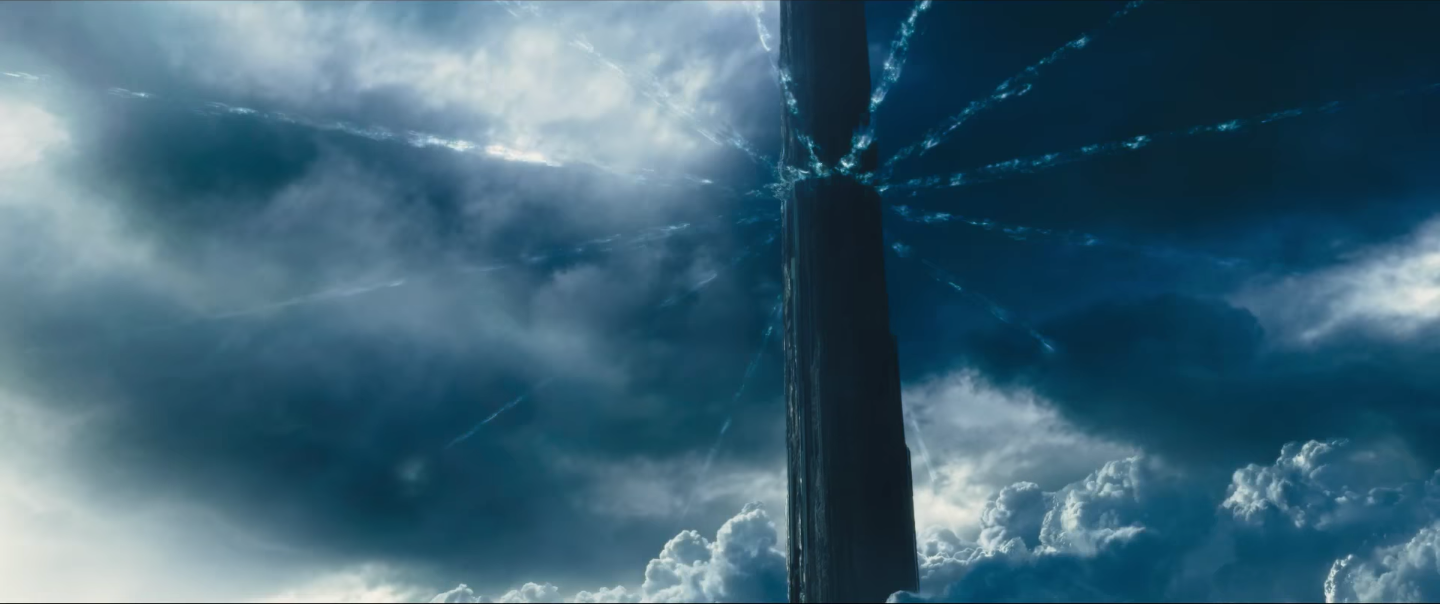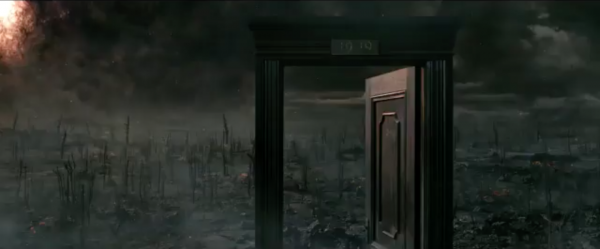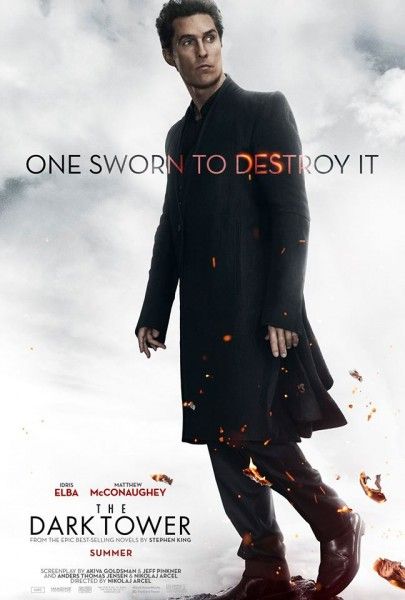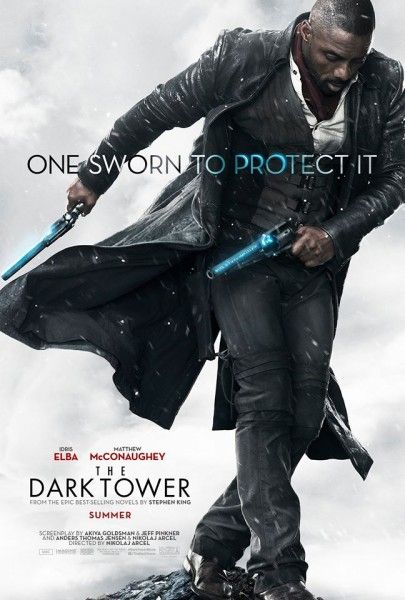SPOILERS abound for folks who aren't caught up on The Dark Tower movie or the books.
With The Dark Tower now in theaters, you're going to see a lot of headlines and hear a lot of conversations about how the movie compares to the vast mythology chronicled in Stephen King's novels. That's certainly worthy of conversation since the Nikolaj Arcel-directed film draws inspiration from across the broad spectrum of King's stories but doesn't delve too deeply into any one of them. Some elements are altered almost beyond recognition, others are tempered to fit a PG-13 rating, and still more are, bafflingly, made darker than the pitch-black source material.
So it's with a fine-toothed cinematic comb that we picked apart The Dark Tower to sort the movie's mythology from that of the books. (It would have been much easier just to write about the things that each medium shared, but such is my ka.) If Sony plans on going ahead with eventual sequels and TV series, then their new turn of the great wheel is likely going to be based on this movie. That's certainly going to ruffle some feathers of book-readers, but if you're not one of them, you'll have to continue reading below to find out what's missing on the big screen.
Here's the synopsis for The Dark Tower movie:
There are other worlds than these. Stephen King’s The Dark Tower, the ambitious and expansive story from one of the world’s most celebrated authors, makes its launch to the big screen. The last Gunslinger, Roland Deschain (Idris Elba), has been locked in an eternal battle with Walter O’Dim, also known as the Man in Black (Matthew McConaughey), determined to prevent him from toppling the Dark Tower, which holds the universe together. With the fate of the worlds at stake, good and evil will collide in the ultimate battle as only Roland can defend the Tower from the Man in Black.
For more on The Dark Tower, be sure to take a look at our recent write-ups below:
- Awesometacular: Jeremy Jahns Talks ‘The Dark Tower’ TV Series
- Stephen King Talks ‘The Dark Tower’, Casting Controversy, and Getting Blocked by Trump on Twitter
- ‘The Dark Tower’ TV Series Sets Glen Mazzara as Showrunner
- ‘The Dark Tower’ Review: You Can’t Do an Epic on the Cheap
- ‘The Dark Tower’ Teaser Reveals the Many Worlds of Stephen King’s “Connected KINGdom”
Roland Deschain, the Gunslinger
- In the books, Roland is known for two things: Being the last Gunslinger, and his myopic quest to find the Dark Tower. Secondary to both of these missions is his desire to put an end to Walter, a.k.a. The Man in Black, a wicked sorcerer who has caused Roland, his family, and the good people of all worlds much misfortune.
- In the movie, Roland is dead set on killing the Man in Black as vengeance for the death of his father, Steven Deschain. The Dark Tower seems to take a backseat to this goal, at least until the final confrontation between Roland and the Man in Black comes to a conclusion just before the movie's end, after which Roland and Jake presumably continue on their merry way. Whether that end is also the real end of the Man in Black himself remains to be seen...
- In the book "The Drawing of the Three", Roland runs afoul of beach-combing creatures known as Lobstrosities, a sort of scorpion crossed with a four-foot-long lobster that's constantly murmuring "Dad-a-chum? Dum-a-chum? Ded-a-chek? Did-a-chick?" (Yeah, it's weird.) While on the beach, Roland loses two fingers, a toe, and a chunk of his calf to the carnivorous Lobstrosities, also acquiring a nasty infection that is eventually cured with medicine found on Keystone Earth.
- In the movie, once Jake and Roland embark on their journey through Mid-World, an attack on the Dark Tower opens a tear in the fabric of reality. A so-called Todash monster escapes through this rift and impales Roland with its tail spike before going after Jake. The two survive, but Roland is left without the use of his right hand and a creeping sickness that's only cured by a visit to a New York City hospital. It's a clever connection to the source material that slightly tweaks the story for this new trip around the wheel.
Jake Chambers
- Jake's backstory is far more complicated in the books than it is in the movie, but let's just focus on his family unit. In the books, Jake is the son of a very successful TV ad executive named Elmer Chambers, who may be Jake's biological father but has very little emotional connection with him. His mother, Laurie, isn't much better; she scarred Jake with particularly dark childhood lullabies and has a tendency to sleep around. Since the Chambers weren't exactly parents of the year, Jake gravitated to his housekeeper Greta Shaw. She was kind to Jake, but ultimately thought his affection toward her as a mother figure was misplaced. All three adults are still alive throughout Jake's story.
- In the movie, however, Jake lost his father to "fire and darkness" which could explain why Jake is having visions of the Dark Tower, the Gunslinger, and the Man in Black. Laurie remarries to a bit of a jerk who grows tired of paying for Jake's psychiatrist/psychologist bills and opts to send him off to a (very nefarious) clinic/camp instead. That plan ends poorly. Jake runs away from home and the Man in Black pays the Chambers a visit, instantly cutting off his step-dad's air supply and eventually burning Laurie to a crisp, once he gets intel as to Jake's whereabouts. (And you thought King's writing was dark...)
- In both the books and the movies, Jake ends up fleeing New York for Mid-World, but the ways in which he gets there are quite different. In "The Gunslinger", Jake arrives at a desert way-station after dying upon being pushed into traffic back in New York City ... yeah. (Once there, it's actually Jake who gives Roland food and water when they meet, though Roland ultimately betrays the boy during their pursuit of the Man in Black.) In "The Waste Lands", Jake and Roland are trapped in a mind-tearing paradox, one which will only resolve once the two are reunited. Jake discovers a Door to Mid-World in the dilapidated Dutch Hill Mansion, a demon known as The Plaster Man--which is basically the house itself coming alive and attacking anyone who tries to use the Door portal--nearly kills him. It's Roland who ultimately pulls him through into Mid-World and to safety.
- In the movie, it's this latter mode of transportation that takes Jake from one world to the next, but the way it all works out is quite different. After fleeing from home, Jake heads to Dutch Hill Mansion thanks to an online tip he received after posting a drawing of the house from his visions on a message board. (Yup.) Jake discovers an electronic panel--which catches his attention thanks to its dial-up internet tones--and punches in the infamous numbers, 19-19. A portal opens, but the house itself soon rises up around him to try to prevent his escape. Jake's own ability--a powerful psychic energy referred to as the "Shine" in the movie; a lesser version of this is called "The Touch" in the books--blasts the splintery demon apart and allows him to walk through the portal into Mid-World, unassisted.
The Man in Black
The nemesis of Roland has many names: Randall Flagg, Walter O'Dim, Rudin Filaro, Raymond Fiegler, Richard Fannin, Walter Hodji, Walter Farden, The Walkin' Dude, The Covenant Man and Marten Broadcloak, to name quite a few. He also appears in books outside the "Dark Tower" series, becoming one of King's favorite go-to uber-villains. He ultimately serves the Crimson King, the evil above all evil, and most of his plans revolve around sowing chaos, destroying the Dark Tower, and ruling over the world that results from its fall. His focus tends to land on Roland, having had a hand in the fall of the Gunslinger's homeland, Gilead. And since Roland, the last Gunslinger, was the one with the best chance of bringing the Man in Black down, the vile sorcerer took great pleasure in killing just about anyone and everyone who's ever walked alongside him.
To do this, in the books, he wielded a variety of powers, including dark magic and sorcery, shapeshifting of both himself and his victims, demonic quasi-immortality, the ability to see across worlds and time through the use of the crystal balls of the Wizard's Rainbow, and, perhaps the most mundane of all of these, an almost scientific curiosity for research.
The movie version of the Man in Black, who also goes by Walter, keeps the shape-shifting off the screen but puts the sorcerer on a near god level of magic. With a word, Walter can turn a daughter against her mother, set someone on fire, or even stop a man from breathing, even if that man is as gifted as the gunslinger Steven Deschain. The Man in Black was indeed an orchestrator of the Fall of Gilead--perhaps glimpsed in the film although in no way in keeping with the chaotic, big-scale version of that event in the books--and directly responsible for the death of Roland's father, setting Roland on the obsessive path for vengeance.
In addition to showing off the Man in Black's powerful speechcraft abilities, he's also seen in charge of the Breakers, the Taheen and Can-toi Low-Men, and some of the Regulators; I'll explain this all later on. The Wizard's Rainbow--13 colored spheres that represent the 12 Guardians of the Beams and the Dark Tower itself--is showcased in the movie as being in the Man in Black's possession, allowing him to track Jake and keep an eye on Roland. There's a lot more to these magical spheres than the movie let on, but just seeing them at all was a nice inclusion, especially since they're likely going to be featured in the eventual TV series. The Man in Black's display of "magicks" at the very end of the film, however, appeared more like parlor tricks and stage magic than the ominous abilities he'd shown throughout the movie. Perhaps this is because Roland has always been resistant to his "magicks", or perhaps because the Man in Black's greatest trick of all was making Roland think he was defeated and dead...
Many Worlds: Keystone Earth
- Sombra Corporation - In the film, this is the cover of the organization that's behind the attempted kidnapping of Jake Chambers, a scheme that uses a pair of poorly disguised Mid-World creatures dressed up in their human skin suits. In the books, the company serves the Crimson King and uses their real estate dealings as a means to do their master's bidding. The Trans Corporation and North Central Positronics are two of their subsidiaries, while the Tet Corporation acts in opposition to Sombra in order to protect the Dark Tower (and Stephen King. Seriously.)
- North Central Positronics - A brief mention of this robotics company is seen when Jake accesses a portal's control panel to flee to Mid-World. However, their history in the books goes back a long, long way. Thousands of years before the current events, North Central Positronics was a company under the Old Ones' empire--the Imperium--tasked with developing cutting-edge technology used to traverse the many worlds in reality. They also attempted to replace the infinitely old, natural Beams that hold up the Dark Tower with technology-based Beams of their own, guarded by cybernetic creatures. The company also fused magic and technology in places called Dogans in order to bring about new, destructive weaponry.
-
Dixie Pig - This rowdy restaurant serves as the Mid-World hangout for can-toi/low men like Richard Sayre (Jackie Earle Haley), lackeys of the Man in Black. It's also the setting for the movie's final battle between the force of good in Roland and the force of evil in Walter, a convenient setting since the Man in Black gets to pop over from Mid-World to perform his "magicks" one last time. In the books, a Door to a Dogan also exists here ... but my god is everything else different. This place is supposed to be, in part, a den of old and powerful vampires known as the Grandfathers who feast on human flesh and blood, the scene of a final sacrifice by a powerful priest, and acts as a waypoint toward bringing one of the series' strangest characters into existence. There's a lot left off the screen here.
- Clement's Guns and Sporting Goods - In the movie, Roland asks Jake if Keystone Earth has guns and bullets, an innocent yet ironic question to which Jake replies, "You're gonna love Earth." They hold up a gun shop owner in order to get beltfuls of ammunition for Roland's thundering guns, and even though it ends up being a trap, Roland winds up with plenty of chances to show off his gun skills. In the book, the manner in which Roland gets his ammo is a much stranger play seeing as he's occupying the body of a psychopathic killer at the time. It's also much more subtle since he manages to trick a pair of police officers in order to get the bullets, a more cerebral plan of attack than sticking up a New York City gun store owner who would 100% be prepared for such an event.
Many Worlds: Mid-World and End-World
- Devar-toi - Also known as Algul Siento and Blue Heaven, this is the very first location revealed in the film. That's a pretty bold move considering that the Mid-World facility (End-World in the books) isn't introduced until the final book in the chronology. The very first scene of the film reveals a bunch of kids at play, watched over by beings who look human until a close-up reveals that their skin is merely a mask; we'll get to them in a minute. After the kids' playtime is over, they're hooked up into a machine that harvests their psychic energy and focuses it into a beam used to assault the Dark Tower itself. The whole thing is overseen by a human warden named Pimli Prentiss (Fran Kranz), who is subservient to the Man in Black. Pretty crazy opening, right? But the books get crazier still. A group of cybernetic Doctor Doom-looking creatures known as the Wolves (who wielded small grenades and energy swords) would bring children from a nearby village to the facility in order to harvest their brain matter, which is then fed to the telepathic Breakers in pill form to enhance their destructive abilities used to assault the Beams holding up the Dark Tower. Yeah. The Devar-toi was also the scene of one of the major climactic battles from the entire series in the books.
- Regulators - This term means a variety of things throughout King's books; there's even a full book with that title, though it's under King's pseudonym, Richard Bachman. Though the term technically isn't used in The Dark Tower movie, the Regulators are Can-toi, or Low Men, and are more servants of the Crimson King. These humanoid creatures with rat heads wear skin masks to blend in; the species is a hybrid descended from matings between humans and Taheen, humanoids with the heads of animals. In the movie, two known Regulators are Sayre and Tirana (Abbey Lee) who get screen time but non-existent backstory.
More Mythology
- Doors - Despite the convenience and apparent prevalence of portals between worlds seen in the movie, there really aren't that many of these functional Doors around. Jake uses at least three in the space of 94 minutes: one at the Dutch Hill Mansion, one at the Calla, and one at the Dixie Pig. There are actually two types of doors in the books: magic doors left over from the creation of the universe and technology-based doors created by the Old Ones. We didn't get to see any of the naturally occurring doors in the movie, but they allow for two-way transportation without any physical side effects. The man-made doors, however, are restricted to one-way travel, can cause nausea (or worse) and have a tendency to break down over the many, many years without proper maintenance. Audiences saw an example of the temperamental doors in the village, but the repair of the ancient technology is beyond most contemporary people throughout the books.
- Beam-Quakes - Another facet of The Dark Tower that's far more prevalent in the movie than it is in the books is the Beam-Quake. This earthquake results from assaults on the tower in the movie, while they only occur when one of the six Beams holding up the tower is destroyed in the books. Since the naturally occurring Beams are actually living entities, with a creature guarding a portal on either end, their death holds significance in the books; when a Beam-Quake happens, devastation follows in its wake. The first to fall in the books was the Eagle-Lion Beam, resulting in the destruction of Gilead. Three more are destroyed by the Crimson King, but thanks to Roland and his fellows, there may yet be a chance for the Beams to recover and heal themselves.
-
Thinnies - Briefly shown in The Dark Tower movie was an interesting interpretation of a Thinny, an erosion of the fabric of reality. These Thinnies appear following Beam-Quakes, threatening to unleash monsters from the dark chaotic region of space into our world. (It's through one of these pulsing, red-and-black, smoke-and-fire Thinnies that a monster escapes and attacks Roland and Jake.) In the books, a Thinny appears as a silver-green cloud of fog that emits an eerie, unpleasant sound that nonetheless lures people into its grasping tendrils. Thinnies occur in a number of King's books including numerous encounters throughout The Dark Tower series.
- The Dark Tower - Speaking of the Tower itself, we see it an awful lot in the film (and its marketing) but it's central to Roland's quest throughout the books. It's not as if he has a GPS pin on it and just has to make the trip, he has to jump through a series of increasingly complicated hoops just to trace a Beam in order to find the thing in the first place. And it's no wonder; the Dark Tower is the center of all creation, a spire of black stone totaling 600 floors that's nigh impregnable thanks to its solitary door made of ghostwood, rising from within a field of roses, and believed to be the body of a god of creation itself. To reach its utmost floor and speak to whatever being resides there is Roland's ultimate goal, one he may spend multiple lifetimes attempting to complete.
- Billy-Bumblers - Perhaps the most important of all Dark Tower mythological elements is the Billy-Bumbler, a sentient raccoon/dog-like creature that has some rudimentary speaking ability by mimicking what they hear last. I'm only half-kidding when I speak of the humble Billy-Bumbler's importance, because a particular one of these creatures by the name of Oy plays a vital role in Roland's quest. These critters are very smart, moreso than even dogs, and were used to herd sheep in ancient times and kept as warnings against particularly powerful storms. They actually appear in the movie as a joke: When Roland sees the talking raccoons on a Geico commercial, he questions whether animals still speak on Keystone Earth. The noble Billy-Bumbler, reduced to a punchline. How sad.
If you made it to the end of this article, congratulations! Your journey is complete! But hopefully this has given you some insight into both how difficult a movie adaptation of The Dark Tower always would be, and just how rich King's mythology has grown to be after all the years he spent on it. It's no wonder than fans who have waited so long to see it on the screen are so passionate about seeing it done right. Whether or not the movie succeeded in that regard, I leave up to you.

